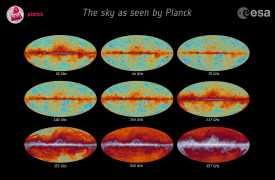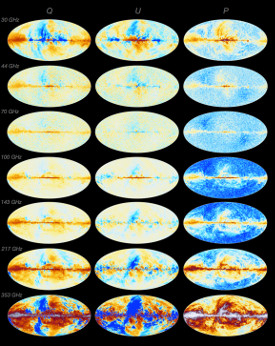Planck Legacy Archive: A guide to why and how
Introduction
ESA's Planck satellite set out to measure tiny fluctuations in the Cosmic Microwave Background (CMB) – the thermal footprint left by the Big Bang. To achieve this, it surveyed the entire sky, covering the frequency range 30 GHz to 857 GHz at nine different wavelengths, spanning the sub-millimetre to radio domains.
The Planck Legacy Archive, which contains data from observations taken over four and a half years of service, is one of the main legacies of the mission. The archive has been prepared by ESA and brings together all of Planck's data products, many of which have been generated by the Planck Low Frequency Instrument (LFI) and High Frequency Instrument (HFI) Data Processing Centres.
Considering the main focus of the Planck mission, the archive naturally includes maps showing the tiny fluctuations in the temperature of the CMB. The study of CMB fluctuations is key to unlocking information about cosmological models and parameters – the quantities that define the expansion and composition of the Universe and the seeds of its large-scale structures.
However, it is not only cosmologists who look to gain from Planck data. The archive is a treasure trove for astronomers, astrophysicists and cosmologists alike, almost all of whom are likely to find data or results within it that will be useful to their research. Among others, this includes: cosmologists using the data to investigate their models and extensions of the laws of physics; astrophysicists studying galactic or extragalactic regions of the sky, or particular objects, at the Planck wavelengths; and even researchers looking at planets within the Solar System.
The archive contents are presented in a way that is accessible to any astronomer who might benefit from its contents. Both casual users and experts are served by the archive, which has a wide range of search and selection options, allowing users to download the FITS files of interest for local processing.
This article acts as a guide to some of the contents of the archive and outlines some of the reasons it may be of use to you. The breadth of the archive spans beyond what is outlined here, since it contains many different types of data – including maps, images, catalogues, time-ordered data, pointing data, spacecraft (or house-keeping) data and cosmology by-products – and generations of products.
This complete version of the Planck Legacy Archive is accompanied by some basic query tools as well as code for deriving cosmological parameters. Additional functionality will be added in future versions of archive.
For full guidelines visit the archive's explanatory supplement, and of course browse through the archive itself.
| Main sections in the article below: |
| Maps |
| Catalogues |
| Tools |
Maps
All-sky maps are perhaps the most well-known product from Planck, which surveyed the entire sky several times over its lifetime. Planck's maps give the best estimate of the observed radiation in both total power and polarisation after calibration and removal of known systematic effects. Two complete data releases have been included in the archive so far, the first (from 2013) including only the first 14 months of data, and the second including all of the data acquired by Planck over its operational lifetime (August 2009 to October 2013).
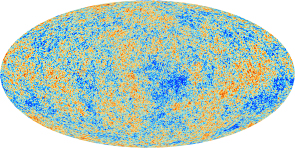 |
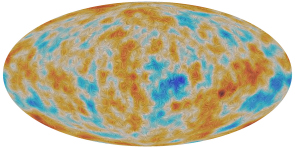 |
|
The Cosmic Microwave Background. Credit: ESA and the Planck Collaboration |
Polarisation of the Cosmic Microwave Background. Credit: ESA and the Planck Collaboration |
The Planck data have been compiled into frequency maps that represent the total emission observed from the sky at each of the nine Planck frequencies. The emission arises from a wide variety of cosmological and astrophysical sources and these individual sources can be viewed and studied in individual maps, known in the archive as component maps.
Frequency Maps
The accumulation of all the data acquired by Planck results in a single 'total power' map at each of the frequencies that Planck observed, which were: 30GHz, 44GHz, 70GHz, 100GHz, 143GHz, 217GHz, 253GHz, 545GHz and 857GHz. In addition to the frequency maps, for each of the 30 to 353 GHz frequencies an additional two maps of polarised emission are produced – these being the Stokes Q and U maps. This basic set of maps, consisting of both total power and polarisation maps, is the most fundamental product of the Planck mission.
The sub-percent calibration accuracy of these maps is extraordinary, making them the most precise maps of the sky ever created at these wavelengths. Whilst most users will probably limit their use to the fundamental products, others who may want to fully exploit the content of the maps will need to characterise it more completely. The archive therefore provides thousands of additional maps that can be analysed and compared so that users can make their own characterisations, for example to find subtle variations in the properties of the maps that may have an impact on their scientific results.
Some of these maps have been built using subsets of the Planck data, for example using a subset of detectors or limited time ranges, and others are simulations based on realistic models of the instruments, the sky, and how the Planck instruments observe the sky. The maps are complemented by data that help the user to understand their properties, for example the nature and distribution of noise, and the shape of the point-spread-function.
The Planck maps were built from a series of time-tagged observations from each detector. These timelines are also provided to users so that they are able to construct their own maps. The archive contains tools for this purpose that allow the user to select timelines according to a specific detector, time period, or region of the sky. One specific application of such special-purpose maps is the study of how the emission from individual objects varies over time.
Component Maps – CMB and foreground
As expected, given the Planck mission's purpose, some of its most valuable outputs are its maps of CMB temperature and polarisation fluctuations. The archive includes several versions of these maps, obtained using different analysis methods, which differe depending on the specific property they are trying to recover. Comparison of these maps provides valuable information about their reliability. For each map, additional information is provided to help with their analysis, for example a mask showing the regions in which confidence in the result is highest.
In addition to the CMB – the most ancient and distant light – the Planck frequency maps also contain more local sources of emission, for example diffuse radiation from our own Galaxy, the Milky Way. In the process of extracting the CMB, maps isolating these local sources were also generated and these contain valuable astrophysical information. The archive provides maps of these foreground emissions detected by Planck, which can be searched by type. Those from the Milky Way include maps of the temperature of dust across the Milky Way, maps of the molecular composition as traced by carbon monoxide, maps of free-free emission – where free electrons are scattering off ions without being captured, often indicating the presence of a HII region – and what is known as diffuse synchrotron emission – the radiation emitted when relativistic electrons spiral through magnetic fields, as in the particle synchrotrons used in experimental physics here on Earth. Maps of a more mysterious emission from the Galaxy, referred to as Anomalous Microwave Emission, which probably arises from very small rapidly spinning dust grains, are also included in the archive.
Moving beyond our Galaxy, Planck provides maps of the diffuse Sunyaev-Zeldovich effect which arises from interactions between CMB photons and the electrons from the hot ionised gas in the halos of galaxy clusters.
Planck data have also been used to generate an all-sky image showing the distribution of dark matter through cosmic time. As the photons of the Cosmic Microwave Background travel through the Universe, they become slightly distorted by the gravitational attraction from the structures that are forming. This distortion can be measured in the Planck data and is what yields a map of the total mass towards each line of sight, integrated over this line of sight. This map, which is also provided via the archive, allows users to make independent estimates of the dark matter distribution in our Universe, in particular to gauge its relation to the distribution of other forms of matter.
Catalogues
By observing such vast swathes of sky Planck has also left as its legacy a series of extensive catalogues which contain lists of specific components – the point-like or compact sources of emission. These sources cover a wide range of objects – from pre-stellar cores to galaxy clusters – and a range of distances – from our Galaxy to the distant early Universe. A key feature of these catalogues is that they cover the whole sky in a rather unbiased way.
These catalogues can be downloaded or queried online, and include observations from the nine frequency channels, seven of which are also sensitive to polarisation. Each catalogue has been released in stages, with the information in the sections below corresponding to the most recent releases, containing full rather than partial mission data.
Planck Compact Source Catalogue
In order to complete the core mission of detecting the CMB the foreground emissions arising from cosmic structures lying between the CMB and ourselves had to be carefully mapped and characterised. The study of the foreground emission has resulted in a catalogue that lists tens of thousands of individual compact sources. For several hundreds of these sources there is also polarisation data.
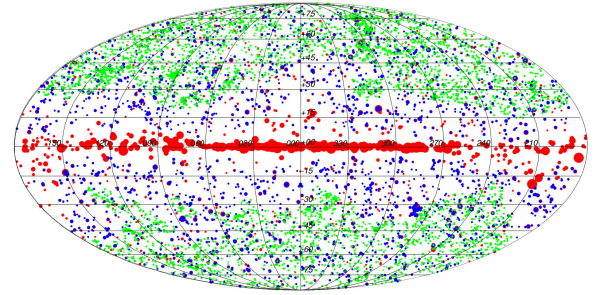 |
| Map of selection of compact sources from the Second Planck Catalogue of Compact Sources. Credit: ESA and the Planck Collaboration |
The sources consist mainly of galaxies located at great distances from the Milky Way, though compact objects within our Galaxy also appear in the catalogue.
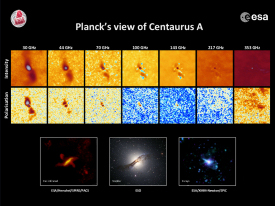 |
|
Planck's view of Centaurus A. Credit: ESA and the Planck Collaboration |
This catalogue will be of great use to researchers working on CMB experiments who want to identify and remove the compact sources contaminating their data; to radio astronomers for extending the range of frequencies currently available from ground-based telescopes; to astronomers looking at far-infrared wavelengths who might benefit particularly from Planck having two channels in common with ESA's Herschel telescope; and to a host of other researchers from diverse fields in astronomy – including optical, infrared, radio, X-ray and gamma ray astronomers – who can use the data in the catalogue to study regions of the sky, or particular objects, at the Planck wavelengths and map the intensity at different frequencies.
Planck Sunyaev-Zeldovich Catalogue
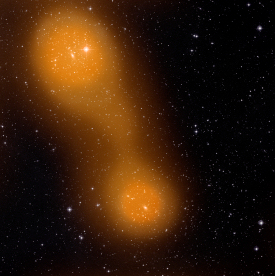 |
| A bridge of hot gas between galaxy clusters Abell 399 and Abell 401. Credit: Sunyaev-Zeldovich effect (orange): ESA & Planck Collaboration; optical image: STScI Digitized Sky Survey |
While the compact source catalogue contains all sources detected in each of Planck channels, specific types of sources can also be isolated by looking for particular spectral signatures. One of these sources is the Sunyaev-Zeldovich effect, which occurs when low energy CMB photons are scattered by high energy electrons found in galaxy clusters, distorting the CMB radiation observed by Planck.
The Planck Sunyaev-Zeldovich (SZ) catalogue is a complete list of SZ detections obtained from the full Planck mission dataset. This extensive dataset thus amounts to an all-sky catalogue of clusters and cluster candidates derived from the detection of the SZ effect.
The catalogue is the largest SZ-selected sample of galaxy clusters yet produced, containing over 1600 detections, of which over 1200 are confirmed clusters with counterparts identified in other datasets. What is more, because the magnitude of the SZ effect is independent of redshift, the catalogue is also the deepest all-sky catalogue of galaxy clusters in existence.
This catalogue is of major astrophysical and cosmological interest and could be of use to, among others: astrophysicists studying galaxy clusters; cosmologists analysing CMB data and determining cosmological parameters who wish to distinguish the SZ effect due to galaxy clusters from ordinary density perturbations; and theorists modelling how the SZ effect is generated by the superheated plasma present at the centre of a galaxy cluster in order to estimate the Hubble constant.
Planck Galactic Cold Clumps
Another set of objects with a specific spectral signature are the very cold and dense regions in our Galaxy where stars begin to form. The catalogue of Planck Galactic Cold Clumps (PGCC) is a list of over 13 000 dense, cold, clumps of matter identified within our Galaxy, over 50 of which are located in the Small and Large Magellanic Clouds. A few of these clumps are also candidates for peculiar high-redshift objects. This is the first all-sky catalogue of Galactic cold sources obtained with homogeneous methods and data. It contains Galactic sources spread across the whole sky with objects included that range from low-mass cores to large molecular clouds.
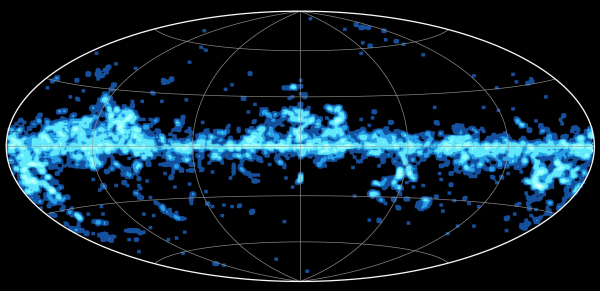 |
| All-sky distribution of cold cores. Credit: ESA and the Planck Collaboration |
Reliable distance estimates have been obtained for over 5000 of the sources, which allows for calculation of physical properties such as their mass, physical size, mean density and luminosity.
This catalogue is of great benefit to astrophysicists studying objects in our Galaxy, in particular those investigating the evolution from molecular clouds to cores. Note that many of these cold clumps also feature in the compact source catalogue.
Tools
The PLA contains not only Planck data but also specialised software for analysing these data. One important - and rather complex - software for use by cosmologists is the Likelihood Code. This is the tool that was used by the Planck Collaboration to derive its own cosmological results and is the Planck product most used by the CMB research community. The Likelihood package consists of data and software that compares the statistical properties of the Planck measurements to those of cosmological models provided by the user, producing as an output the constraints set by Planck measurements on the parameters relevant for each model. The code can be tailored to different data inputs for instance to allow users to gauge the stability of the results.
The PLA also provides, as standard, options to choose maps based on data from one or both instruments, from all or a subset of the frequencies, from part or all of the mission surveys. In addition, the individual catalogues can be searched by source name or coordinates, and by flux levels.
Resources
Planck legacy archive explanatory supplement.
Planck 2013 results. XV. CMB power spectra and likelihood, published in A&A, Vol 571, A15, November 2014.

